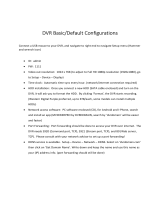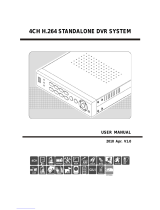
vi
vivi
vi
3.6.1
General PTZ control (if PTZ cameras are installed) ........................................................................22
3.6.2
Express Control of PTZ.........................................................................................................................23
3.7 LAYOUT......................................................................................................................... 25
3.7.1
Bring to full screen mode ......................................................................................................................25
3.8 CHANNEL
SWITCHING............................................................................................... 25
3.9 DISPLAY ........................................................................................................................ 26
3.10 SEQUENCE.................................................................................................................. 26
3.11 ZOOM........................................................................................................................... 26
3.12 SEARCH....................................................................................................................... 27
3.12.1
Time Search...........................................................................................................................................28
3.12.2
Event Search..........................................................................................................................................29
3.13 COPY............................................................................................................................ 30
3.14 LOGOUT...................................................................................................................... 31
4 DVR CONFIGURATION.................................................................................................. 32
4.1 CONFIGURATION MENU............................................................................................ 32
4.2 EXPRESS........................................................................................................................ 32
4.3 CAMERA SETTING ...................................................................................................... 35
4.3.1
Basic Setting..........................................................................................................................................35
4.3.2
Video Adjust ..........................................................................................................................................37
4.3.3
Motion ...................................................................................................................................................38
4.3.4
Video Loss.............................................................................................................................................41
4.4 RECORD & PLAY SETTING........................................................................................ 42
4.4.1
Record ...................................................................................................................................................42
4.4.2
Built-in Calculator ................................................................................................................................43
4.4.3
Play .......................................................................................................................................................44
4.5 ALARM & EVENT SETTING....................................................................................... 45
4.5.1
Alarm.....................................................................................................................................................45
4.5.2
Event......................................................................................................................................................47
4.5.3
Schedule Setting ....................................................................................................................................54
4.5.4
Express Setup ........................................................................................................................................54
4.5.5
Holidays ................................................................................................................................................55
4.5.6
Schedule ................................................................................................................................................56
4.5.7
Alarm Action .........................................................................................................................................61
4.6 NETWORK SETTING.................................................................................................... 65
4.6.1
LAN .......................................................................................................................................................65
4.6.2
EMAIL...................................................................................................................................................67
4.6.3
DDNS ....................................................................................................................................................68
4.6.4
Alarm Server .........................................................................................................................................70
4.7 D
ISK
I
NFORMATION
.......................................................................................................... 71
4.7.1
Disk .......................................................................................................................................................71
4.8 DISPLAY SETTING....................................................................................................... 72
4.8.1
Monitor OSD.........................................................................................................................................72
4.8.2
Main M/T SEQ ......................................................................................................................................73
4.9 SYSTEM SETTING........................................................................................................ 74
4.9.1
Date/Time..............................................................................................................................................74
4.9.2
Daylight Saving.....................................................................................................................................75
4.9.3
User.......................................................................................................................................................76
4.9.4
I/O Control............................................................................................................................................79























